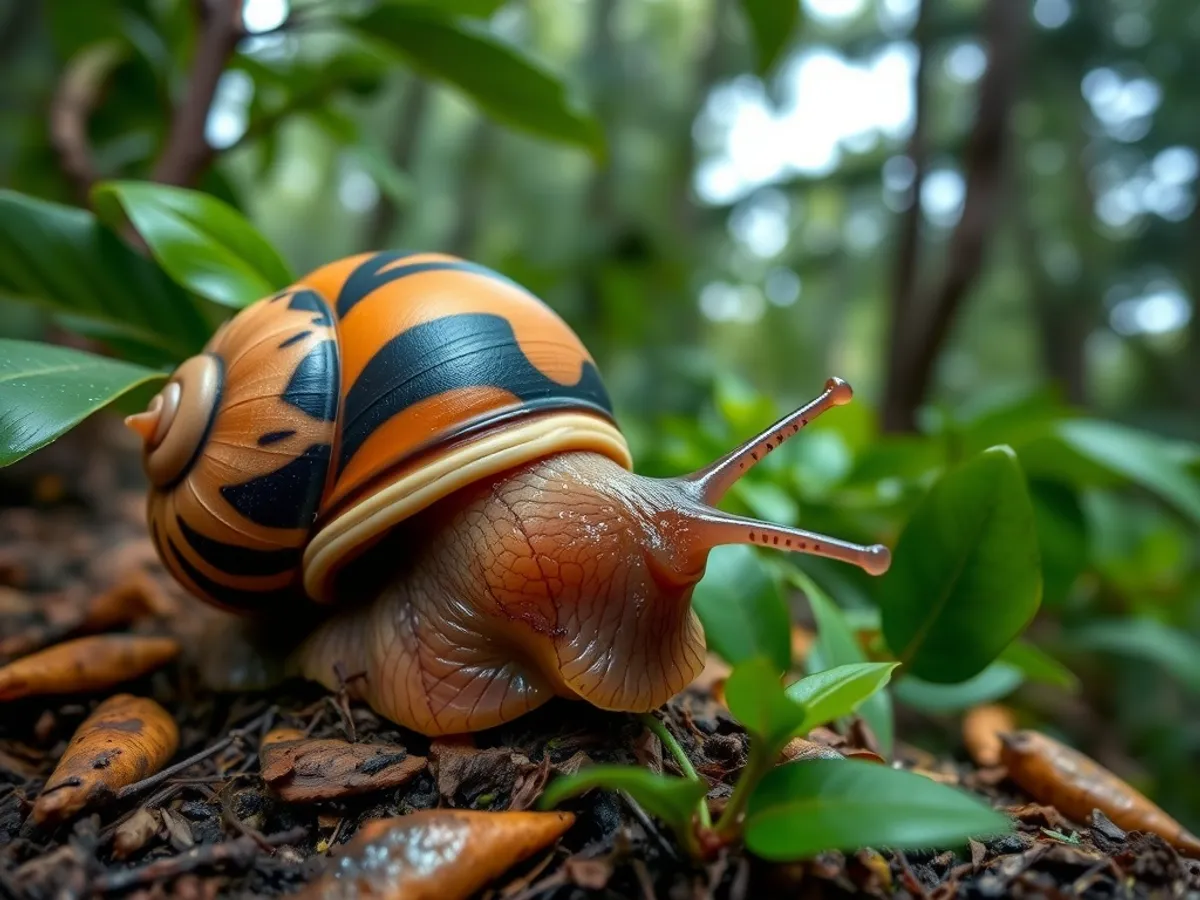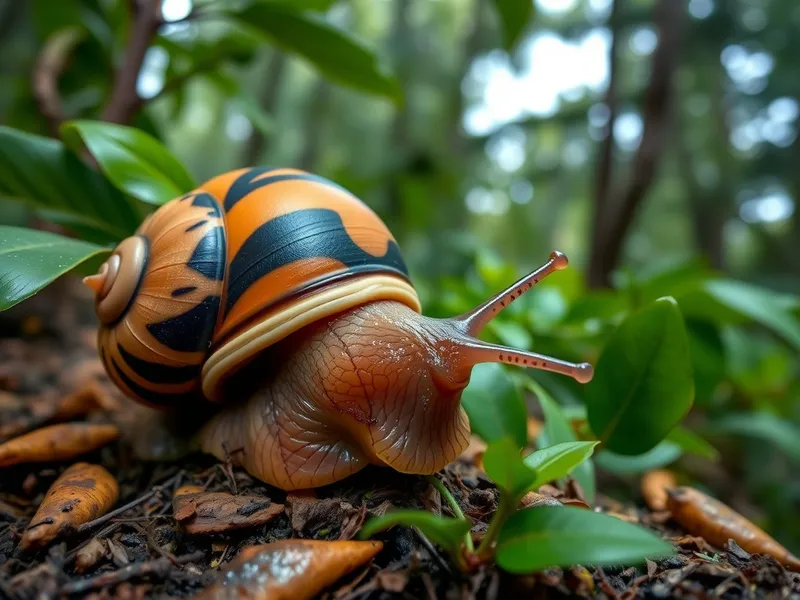
Giant tiger land snail
Achatina achatina

Meet the Giant tiger land snail
The giant tiger land snail, also known as Achatina achatina, is one of the largest terrestrial gastropods in the world, native to the rainforests and humid lowlands of West Africa. It is easily recognized by its large, conical shell, which features striking brown and yellow tiger-like stripes. This nocturnal mollusk is primarily herbivorous, feeding on a wide variety of plant material, fruits, and occasionally decaying organic matter. The giant tiger land snail plays a vital role in nutrient cycling within its ecosystem, but when introduced outside its native range, it can become an agricultural pest.
Classification
Invertebrate
Habitat
Tropical rainforest
Diet
Herbivore
Lifespan
5-10 years
Conservation
Least Concern
Weight
200-500 grams
📖Fascinating Facts
Record-Breaking Size
Achatina achatina holds the record for the largest land snail shell ever documented, with some individuals reaching 30 cm in length and 13 cm in diameter.
Prolific Egg Layers
These snails are capable of laying hundreds of eggs at a time, with each egg being among the largest laid by any snail species.
Ecosystem Role
By breaking down decaying plant matter, giant tiger land snails help recycle nutrients and maintain soil health in their native habitats.
📋Detailed Description
The giant tiger land snail (Achatina achatina) is among the largest terrestrial gastropods, with adult shells reaching up to 20–30 cm in length and weighing over 500 grams. Its shell is characteristically conical and robust, displaying vivid brown and yellow banding reminiscent of tiger stripes, which provides camouflage among leaf litter. The snail's body is soft, muscular, and typically grayish to brown, with a large, retractable foot that secretes mucus to aid in locomotion and moisture retention. Two pairs of tentacles are present: the upper, longer pair houses the eyes, while the lower pair is used for tactile and chemical sensing. Achatina achatina is primarily nocturnal, emerging at night or during periods of high humidity to forage, and retreats to moist microhabitats during the day to avoid desiccation. Its radula, a specialized rasping tongue, allows it to scrape a wide variety of plant materials, including leaves, fruit, bark, and even decaying organic matter. This species is hermaphroditic, possessing both male and female reproductive organs, and can store sperm for several months, allowing for delayed fertilization. The snail plays a critical role in nutrient cycling by breaking down plant detritus and enriching soil with its waste. In its native West African range, it is an important part of the ecosystem, but when introduced elsewhere, it can become a highly invasive agricultural pest.
💡 Did you know?
A single giant tiger land snail can lay up to 1,200 eggs in a single year, leading to rapid population growth if not controlled.
🔬Research & Sources
Wikipedia Summary
Achatina achatina, commonly known as the giant African snail, also known as the giant tiger land snail is a species of large, air-breathing land snail, a terrestrial pulmonate gastropod mollusk in the family Achatinidae. The name "Achatina" is from "achates", Greek for agate. It shares the common name "giant African snail" with other species of snails such as Lissachatina fulica and Archachatina marginata.
Last Modified: 5/9/2025
🎭Behavior & Social Structure
Achatina achatina is a solitary species, with individuals typically foraging alone except during mating periods. It exhibits crepuscular and nocturnal activity patterns, becoming most active after rainfall or in high humidity conditions. The snail uses chemoreception to locate food sources and mates, following scent trails left by conspecifics. Feeding involves using the radula to rasp plant surfaces, and the species is known to consume a wide variety of vegetation, including crops when present in agricultural areas. During dry periods or drought, the snail can enter a state of estivation, sealing itself within its shell with a mucous epiphragm to conserve moisture. Social interactions are limited, though aggregations may occur in optimal microhabitats or during breeding. Defensive behaviors include rapid withdrawal into the shell and the secretion of copious mucus to deter predators.
👶Reproduction & Life Cycle
Achatina achatina is a simultaneous hermaphrodite, meaning each individual possesses both male and female reproductive organs. Mating typically occurs during the rainy season, when environmental conditions are optimal for egg survival. Courtship involves reciprocal tactile stimulation with the tentacles, followed by copulation, during which both individuals may exchange sperm. Fertilization is internal, and after a gestation period of 2–4 weeks, the snail lays clutches of 100–400 eggs in moist soil or leaf litter. The eggs are large (up to 1.5 cm in diameter) and have a calcareous shell. There is no parental care after oviposition; juveniles hatch fully formed and begin independent life. Under favorable conditions, Achatina achatina can reproduce several times a year, contributing to its potential for rapid population growth.
🛡️Adaptations & Survival
Key adaptations of Achatina achatina include its large, robust shell for protection against predators and desiccation, and the ability to secrete a mucous epiphragm to survive extended dry periods. Its radula is highly efficient at processing a wide range of plant materials, allowing dietary flexibility. The snail's nocturnal and humidity-dependent activity reduces water loss and predation risk. Its reproductive strategy—hermaphroditism and high fecundity—enables rapid colonization of new habitats. The ability to store sperm for months allows for reproductive success even when mates are scarce. Chemoreceptive tentacles enhance environmental awareness, aiding in food and mate location.
🎨Cultural Significance
Achatina achatina holds significance in several West African cultures, where it is harvested for food due to its high protein content. The shells are sometimes used in traditional crafts, jewelry, and as containers. In folklore, the snail is often associated with patience and resilience, symbolizing slow but steady progress. In some regions, it is used in traditional medicine, believed to have healing properties. Its invasive status has also made it a subject of agricultural policy and biosecurity education in affected countries.
🔬Recent Research & Discoveries
Recent research has focused on the snail's role as a vector for plant and human pathogens, particularly the rat lungworm (Angiostrongylus cantonensis), which can cause eosinophilic meningitis in humans. Studies have examined its rapid growth rates, reproductive biology, and adaptability to diverse environments, contributing to understanding its invasive potential. Genomic and proteomic analyses are underway to explore its physiological adaptations to desiccation and environmental stress. Conservation genetics research is also being conducted to assess population structure and gene flow within native and introduced ranges.
🎥Wildlife Videos

Giant Tiger Land Snail ( Nature's Striped Marvel ) #facts #fascinatingcreatures #animals #wildlife
The Giant Tiger Land Snail, also known as Achatina achatina or the Giant African Snail, is one of the largest land snails in the ...
Junior Animal Biology

Giant Snail Uses "Snorkel" to Breathe Underwater | How Nature Works | BBC Earth
Floods are slowly suffocating the Pantanal's ecosystem, but luckily, these ingenious water-breathing snails might be able to save ...
BBC Earth

African Giant Snail | animal documentary
African Giant Snail | animal documentary The African giant snail, one of the most invasive mollusks on the planet, takes center ...
Cityanimal EN

Why African Land Snails Are Dangerous to Humans
Florida, already full of terrifying animals and critters, is now battling massive invasive snails. African land snails were first detected ...
Inside Edition

Sea Snail vs Land Snail! #Documentary #SeaSnail #LandSnail #Nature#EpicShowdown#Mollusks#SnailBattle
Sea Snail vs Land Snail! #WildlifeDocumentary #SeaSnail #LandSnail #Nature #EpicShowdown #Mollusks #SnailBattle ...
Animals World.official

Slow down with Snails and Slugs | Relax With Nature | BBC Earth
Allow yourself to move at a snail's pace and relax with the movement of these slow-moving creatures. Subscribe: ...
BBC Earth
🌍Habitat Information
The Giant tiger land snail typically inhabits Tropical rainforest environments. Giant tiger land snails have adapted to their environments with specialized features and behaviors.
Primary Habitat:
Tropical rainforest
More detailed habitat information will be available soon.
🛡️Conservation Status
The Giant tiger land snail is currently classified as Least Concern. Conservation efforts are crucial for preserving this species for future generations.
Common Threats:
- 🏠Habitat loss and fragmentation
- 🌡️Climate change impacts
- 🎯Hunting and poaching
- 🏭Human-wildlife conflict
⚠️Threats & Conservation Challenges
In its native range, Achatina achatina faces predation from birds, mammals, and some reptiles, as well as parasitism by nematodes and trematodes. Habitat loss due to deforestation and agricultural expansion poses localized threats. However, the species is highly adaptable and currently classified as Least Concern by the IUCN. Invasive populations outside Africa, particularly in parts of Asia and the Americas, are subject to eradication efforts due to their status as agricultural pests and potential vectors for plant and human pathogens. Human collection for food and the pet trade can impact local populations, but overall numbers remain stable in most areas.
🔬Scientific Classification
Scientific Name
Achatina achatina
Classification Hierarchy
🔍 About Taxonomic Classification
Taxonomic classification is a hierarchical system used by scientists to classify and organize living organisms based on shared characteristics and evolutionary relationships.
The system moves from broad categories (Kingdom) to increasingly specific ones, with each animal's scientific name typically consisting of its Genus and species.
📝Community Notes
Share your observations and insights about the Giant tiger land snail with our community of wildlife enthusiasts.
Join Our Community
Sign in to share your observations and connect with fellow wildlife enthusiasts.
Sign In to ContributeNo community notes yet
Be the first to share your observations about the Giant tiger land snail!
Explore Giant tiger land snail
Select a tab above to learn more about this amazing animal.
📸Photo Gallery
No photos available for this animal yet.
🌟Discover More Wildlife
Continue your journey of discovery with more fascinating animals from our database
